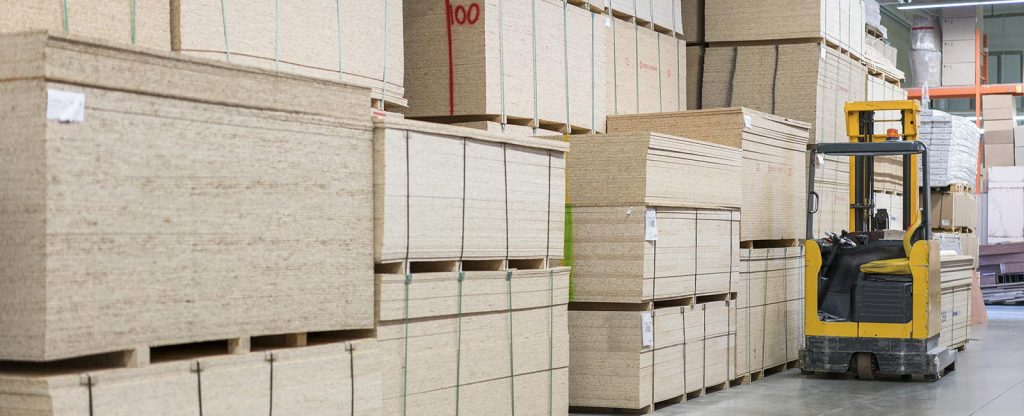The strength, durability and aesthetics of plywood have made it popular for use in construction, furniture-making and even in the shipbuilding industry. The fact that it’s easy to work with is a plus.
But how is plywood made? Read on and find out the basic steps in the plywood manufacturing process, including one that reveals how the flat plywood sheets that we know and love to use are initially put together.
Selecting logs and conditioning
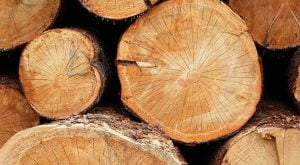
The entire plywood-making process begins with log selection. At this stage, both hardwood and softwood logs are carefully identified and segregated in terms of species and quality. The primary objective here is to find logs that would produce veneers with acceptable physical and aesthetic characteristics. Some of the more commonly used hardwoods and softwoods in making plywood are ash, maple, mahogany, Douglas fir, and select pine, cedar and spruce varieties.
Once suitable logs are selected, they are then made to go through a conditioning process to assure that good quality veneer is produced during the peeling process. This process usually involves spraying the logs with water.
Cutting and Debarking
The next step in the plywood making process is to measure the conditioned logs for crosscutting. Once the logs have been cut to length, the bark will then be removed using a debarking machine. The debarking process also aims to improve cross-section roundness.
Peeling and clipping
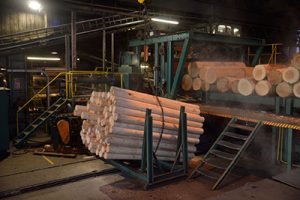
Using a rotary lathe machine, the logs will be peeled into thin veneers. The veneers produced can come in the form of continuous sheets, or immediately clipped into a predetermined width and length.
Since the quality of the veneer is one of the single most important factors in determining plywood grade, veneers with visible defects are clipped off. As a result, clipping leaves some veneers with a smaller surface area. This, however, isn’t a problem, because these smaller veneers can be joined together to form standard 4×8 or 3×7 sheets.
Drying the veneer
As you can expect, the green veneers produced by the peeling process are typically wet or full of moisture. These must be dried to improve bonding.
Veneer drying is done by feeding the veneers into continuous or roller dryers at a controlled speed. These dryers produce heat from steam boilers that are fuelled by barks, discarded veneers, sawdust and other mill residues. Ideally, the moisture content of veneers should only be somewhere between six to 14 per cent by the time they make it through the other end of the dryer.
Composing the sheets
After properly drying and trimming the veneers, they are then composed into final 4×8 sheets. At this stage, they are also segregated as face, core or back veneers. The face is the surface that is to be used or seen. The back, as the term suggests, is the part that remains unused or hidden. The core, meanwhile, refers to the centre layer. The process is meant to make composing the plywood layout easier. The plywood layout, for its part, will be controlled in terms of thickness, timber grain orientation, wood species, and the quality of the ply.
Bonding using adhesives
Once the sheets are properly composed, they are then bonded with the use of adhesives. The adhesives to be used at this point will depend on the type of plywood being produced. If the plywood is meant to be of the general or normal type, urea formaldehyde resins are typically used. Marine plywood, on the other hand, uses melamine or phenol-based adhesives.
To make sure the adhesive is evenly spread on alternate layers of veneer, mills pass the veneers through a mechanical glue spreader.
Then each veneer sheet or ply is bonded to another sheet in odd-numbered layers. Each sheet is also rotated to a different angle before being bonded to another. This creates a “cross-graining” that results in much stronger plywood.
Cold press, then hot press
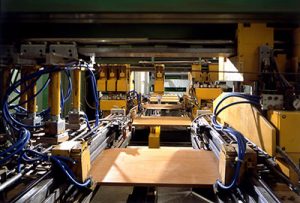
The composed panels are then pre-pressed in a cold press at an ambient temperature and a controlled hydraulic pressure. This process usually takes 20 minutes, which is enough time for the adhesive to solidify and effectively bond the veneer plies in each panel. Aside from helping with bonding, this process also helps flatten the plywood.
To assure excellent bonding, the pre-pressed panels will then be put into a hot press. This process takes approximately three to seven minutes, although the time—as well as the temperature—may vary depending on the wood species, the veneer thickness and the design of the plywood.
All of this creates a much denser finished material. The thickness of the final plywood is determined by the number of veneer layers compressed.
Quality check
After the pressing process, the panel is ready for quality control. Samples will be randomly picked and tested for mechanical strength, bonding strength as well as formaldehyde emission levels. A visual check will also be performed, and should there be any gaps, they will be filled with putty.
Sanding and trimming
Once the plywood passes quality control, it will then be sanded to make sure the surface has a smooth surface and its thickness uniform. Depending on market specifications, the plywood can either be sanded on the face side or both face and back sides. After sanding, the plywood will then be trimmed to its final size.
Packing, stacking and stamping
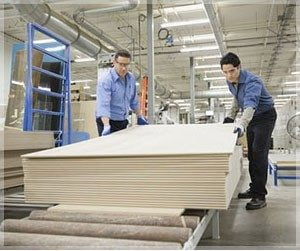
Finally, the finished plywood will be packed, stacked and stamped accordingly for shipment to both local and overseas markets. The stamps will usually indicate a grade-trademark that is meant to inform buyers about the plywood’s exposure rating, grade, mill number, and other factors.
The plywood manufacturing process is quite interesting, isn’t it? Now that your question, “How is plywood made?” has been answered, you now know that a lot of effort is poured into each sheet of plywood. This way, people are assured that they have a high-quality product in their hands which they can use for just about any building project they embark on.
If you need assistance in picking out the best plywood for your project, contact us today. FA Mitchell can guide you through all types of exterior and interior plywood, for various uses including floors, plywood ceilings, plywood cladding, acoustic plywood finishes, and like.

